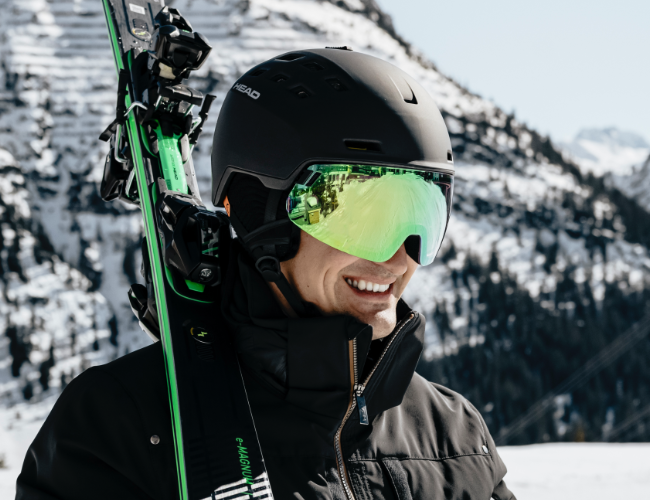
FIND THE RIGHT SIZE
The fitting of a helmet is crucial for your safety. HEAD helmets generally come in four shell sizes (XXS, XS/S, M/L, XL, XXL) which allows for a more individual fitting. Wearing a too big helmet puts unnecessary weight on your head which influences the effects of an impact on your head tremendously.
CHINSTRAP ADAPT
If you want to find out which shell size is right for you, use a measuring tape, place it above your ears and eyebrows and measure your head circumference in cm. Afterwards you can look up your shell size in our size chart.

WHAT IS THE BEST FIT FOR MY HELMET?
If you want to optimize the individual fit of your helmet choose a model with Sphere Fit, or at least a size adjustment system. These use dials and, if you choose a professional BOA system, laces assure a snug fit.
HOW DO I MEASURE MY HEAD?
HOW BIG IS THE HELMET?
The helmet size mostly covers a size range of multiple centimeters and can be adjusted according to your individual head circumference. As an example, if you have a head circumference of 58 centimeters, a HEAD helmet in size M/L, which covers the range between 56 – 59 centimeters, is correct for you.
HOW DO I USE A HELMET?
HEAD winters sports helmets are certified for snow sports according to EN CE 1077 and/or ASTM 2040. Therefore, our helmets can be used for all activities covered within this norm. Make sure that you have the correct and snug fit by using the adjustment options on the helmet.
CAN I BUCKLE THE HELMET?
HOW TO FIND THE RIGHT HELMET?
Helmet sizing varies by manufacturer, the above chart is a reference for some HEAD helmets.
For the right size please check the size chart on the specific product site.
WHAT SHOULD I TAKE INTO CONSIDERATION WHEN BUYING A HELMET?
When buying a winter sports helmet, it is important to consider the following points to find the perfect model for your needs:
CONSTRUCTION TECHNOLOGY:
Hard-shell: Hard-shell is the strongest, most impact resistant helmet technology with a lifespan that is without equal
In-Mold: In-Mold provides perfect protection at minimum weight. A shock absorbing inner EPS core is injected into the hard outer polycarbonate layer to create a single comprehensive unit
Visor: Visor helmets combine the advantages of a helmet & goggle combo in one product, they are also a great option in case you are wearing prescription glasses. We offer a variety of visor helmets, including the modern, award winning RADAR and RACHEL models.
WEIGHT:
Weight is one of the most important factors that influence the outcomes of impacts. As said above, heavier helmets increase the forces that effect your head (Force=Mass*Deceleration) due to the law of inertia. Therefore, you will want to get a helmet light enough to not limit you in your movement.
VENTILATION:
Since weather conditions can vary tremendously, even within one day, the heat management of your head is important to secure a relaxed and comfortable experience. A helmet with well-engineered ventilation provides exactly that.
All HEAD helmets come with a natural ventilation system that takes care of a general basic heat exchange. Thermal ventilation draws warm, moist air away from the head, but doesn’t let cold air in.
In addition, some models are equipped with an adjustable ventilation system which you can manually adjust. If you want warmth and moisture to get out on warm days you open the slots, if you want to shelter your head from snow and wind on cold days you close them.
HOW DO I KNOW THAT THE SIZE OF MY SKI HELMET IS OKAY?
HOW DO I MEASURE MY HEAD SIZE?
Take a soft measuring tape and wrap it around your head about 3 fingers above your eyebrows and ears. Most helmets are measured in centimeters, so unless you love calculations, measure your head in centimeters.



